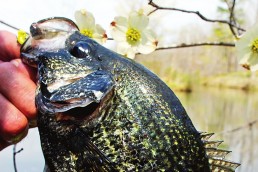Don’t just Slow Down: ‘Stop it’
SHARE THIS POST
How many times must we learn the same lesson over and over again where some never learn?
Back in the early 1970s, we fished many bass tournaments, some local club events and big national contests. One memorable event on an Indiana reservoir started frustratingly slow: midmorning with no fish. Intently concentrating as my Texas-rigged worm was worked through another underwater bush and I was disappointed that another piece of cover hadn’t produced a fish, my rod was laid down so I could go get a drink of water.
After several gulps, my line started swimming off. Pow. I grabbed the rod and a hook-set, a short battle ensued, and the first bass of the day came in weighing 3 pounds and went into the livewell.
But had that fish just told me something?
For the rest of the day I let the lure stop, especially after cover produced a limit of nice bass for a win. Even my co-angler never had a clue what my technique was as he went fishless.
I wish my memory could recall the guide’s name from Florida who had a sports show seminar years ago called “Deadsticking.” He had many photos, stories and examples of trophy fish using this stopped-lure technique.
Last August, my fishing pal Gary Clark from Florida called.
“Can you rescue me from this 100-degree heat, Dan? I want to come up north and fish.”
So, the following Sunday I collected him from O’Hare and up to Door County we went.
Our guide and fishing friends said Rowley Bay had been on fire with lots of big smallmouths the previous week, so Monday we were full of anticipation. After a full day of steady, hard fishing at Rowley, we had one 13-inch fish on a Ned Rig.
Studying and planning for the next day resulted in a fair run of 50 smallmouths, but few bigger ones. By the end of that day we had evolved our presentation into a drop-shot rig to keep our lures above both live weeds and decaying ones on the bottom.
While helping my friend land a nice smallmouth, a big one took advantage of my resting lure and almost stole my rig. Again, the fish was telling me something. It had told me to “stop it.”
I listened, and we complied.
Are you enjoying this post?
You can be among the first to get the latest info on where to go, what to use and how to use it!
By the third day, a guide accompanying us was taking photos of fish and rigs as we went from 1 to 100 fish. Guides and other anglers were moving in on us, throwing jerkbaits, jigs, spinnerbaits and even drop-shot rigs and other lures with hardly any fish until they zoomed away.
Our secret was to cast our drop-shot rigs and “stop.”
“Wow—I think this beats any live bait!” Gary exclaimed.
These were big, quality smallmouths.
The guide said he’d never had so many big smallmouths come into his boat in one day.
By the fourth day, super-guide Bret Alexander replaced his planned muskie trip to come see what we were doing. With intimate knowledge of these waters, he expanded our fishing area and we quit counting at 125 nice-sized bass. Again, it was a record for quality bass in one day in his boat with many back-to-backs and double hook-ups.
Last September, Elite BASS pro Seth Feider stunned the angling world in the three-day contest on Mille Lacs with 15 bass weighing in at 76 pounds, 5 ounces. His technique was to cast his drop-shot rig near isolated boulders where few but big fish hung out.
Feider reported that he had just let it sit for sometimes over six minutes without even moving his rig and then it would swim off. Of course, fish must be there for this to work, and modern sonar units and experience can determine this. But even in smaller waters where fish are known, it works.
When I returned from Door County to fish my home waters, I took my biggest largemouth of the year on the same drop-shot rig while it was stopped. My belief is that so many of these fish have been hooked so many times thanks to CPR (catch photograph and release). These lunkers have become very cautious, carefully studying a bait before committing to it. And even the calmer moving waters give these lures a subtle action.
Jordan Lee turned lemons into lemonade by staying in one area, casting his dressed jig, and letting it sit. Watching the contest online and in the Expo, we had seen many competitors cranking faster and faster as they saw their chances slipping away.
I would keep yelling, “Stop it!” but they were miles away on Conroe and probably wouldn’t or couldn’t slow down let alone “stop” with the pressure they were feeling.
Many will read or even observe this, and will find it impossible to commit to a do-nothing retrieve. But don’t just slow down: stop it.
MWO
SHARE THIS POST
Did you enjoy this post?
You can be among the first to get the latest info on where to go, what to use and how to use it!
Dan Basore
Dan Basore is a fishing historian and steward of the history of the sport. In his efforts to preserve fishing history, he is always on the lookout for information about early lure makers, old lures, pre-level wind reels, manufacturer catalogs, tournament casting items and the like. If you possess information or materials of this kind, please contact him at 630-393-3474 or by email at ollures@aol.com.



